D Link DI524D1 AirPlus G 802.11g/2.4GHz Wireless Router User Manual DI 624 071003
D Link Corporation AirPlus G 802.11g/2.4GHz Wireless Router DI 624 071003
D Link >
Contents
- 1. Manual 1
- 2. Manual 2
- 3. Manual 3
Manual 2
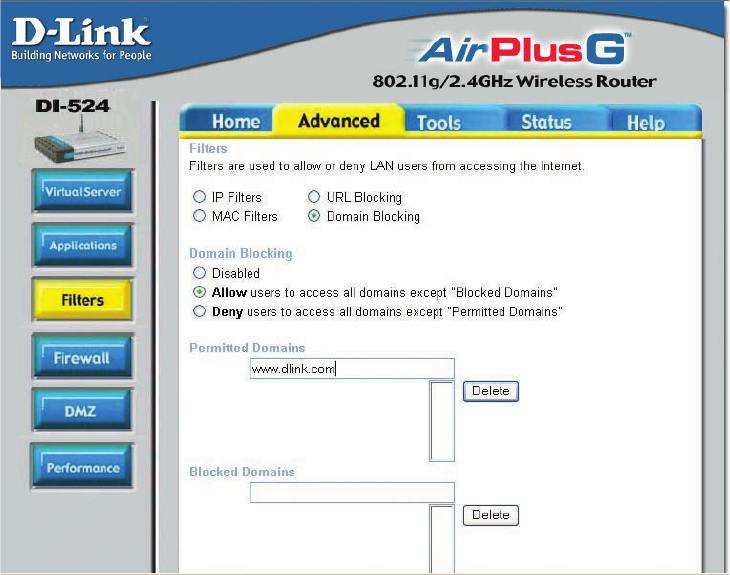
26
Using the Configuration Menu
Advanced > Filters > Domain Blocking
Filters-
Domain Blocking-
Blocked Domains-
Permitted
Domains-
Domain Blocking is used to allow or deny LAN (Local Area Network) computers from
accessing specific domains on the Internet. Domain blocking will deny all requests to a
specific domain such as http and ftp. It can also allow computers to access specific
sites and deny all other sites.
Select the filter you wish to use; in this case, Domain Blocking
was chosen.
Disabled-
Allow-
Deny-
Enter the Permitted Domains in this field.
Enter the Blocked Domains in this field.
Select Disabled to disable Domain Blocking.
Allows users to access all domains except Blocked Domains.
Denies users access to all domains except
Permitted Domains.
(continued)
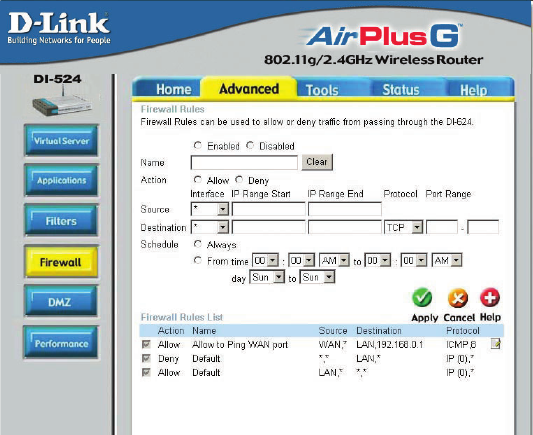
27
Using the Configuration Menu (continued)
Advanced > Firewall
Firewall Rules is an advanced feature used to deny or allow traffic from passing
through the DI-524. It works in the same way as IP Filters with additional settings.
You can create more detailed access rules for the DI-524. When virtual services are
created and enabled, it will also display in Firewall Rules. Firewall Rules contain all
network firewall rules pertaining to IP (Internet Protocol).
In the Firewall Rules List at the bottom of the screen, the priorities of the rules are
from top (highest priority) to bottom (lowest priority.)
Note:
The DI-524 MAC Address filtering rules have precedence over the Firewall Rules.
Firewall Rules- Enable or disable the Firewall.
Name- Enter the name.
Action- Allow or Deny.
Source- Enter the IP Address range.
Schedule- Select Always or enter the Time Range.
Destination- Enter the IP Address range, the Protocol,
and the Port Range.
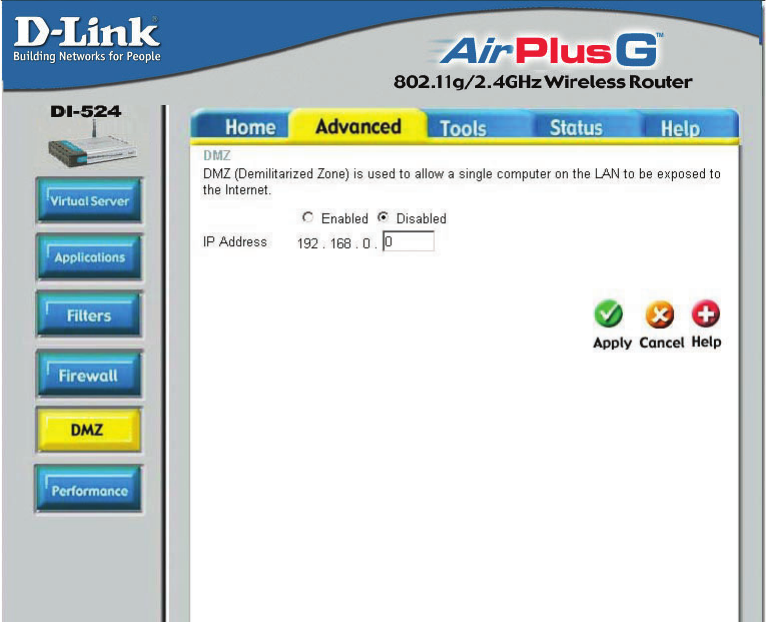
28
Advanced > DMZ
Using the Configuration Menu (continued)
If you have a client PC that cannot run Internet applications properly from behind the
DI-524, then you can set the client up for unrestricted Internet access. It allows a
computer to be exposed to the Internet. This feature is useful for gaming purposes.
Enter the IP address of the internal computer that will be the DMZ host. Adding a
client to the DMZ (Demilitarized Zone) may expose your local network to a variety of
security risks, so only use this option as a last resort.
DMZ- Enable or Disable the DMZ. The DMZ (Demilitarized Zone)
allows a single computer to be exposed to the internet. By
default the DMZ is disabled.
IP Address- Enter the IP Address of the computer to be in the DMZ.
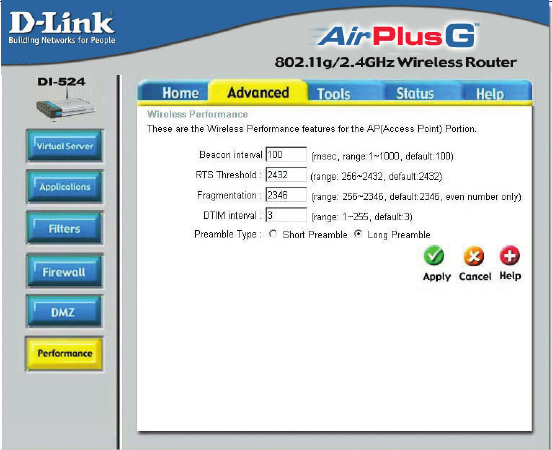
29
Using the Configuration Menu (continued)
Advanced > Performance
Preamble Type- Select Short or Long Preamble. The Preamble defines the
length of the CRC block (Cyclic Redundancy Check is a com-
mon technique for detecting data transmission errors) for com-
munication between the wireless router and the roaming wire-
less network adapters. Auto is the default setting. Note: High
network traffic areas should use the shorter preamble type.
Beacon Interval- Beacons are packets sent by an Access Point to synchronize a
wireless network. Specify a value. 100 is the default setting and
is recommended.
RTS Threshold- This value should remain at its default setting of 2432. If inconsis-
tent data flow is a problem, only a minor modification should be
made.
Fragmentation- The fragmentation threshold, which is specified in bytes, deter-
mines whether packets will be fragmented. Packets exceeding
the 2346 byte setting will be fragmented before transmission.
2346 is the default setting.
DTIM interval- (Delivery Traffic Indication Message) 3 is the default setting. A
DTIM is a countdown informing clients of the next window for
listening to broadcast and multicast messages.
Wireless
Performance-
Displayed in this win-
dow are the Wireless
Performance fea-
tures for the Access
Point portion of the
DI-524.
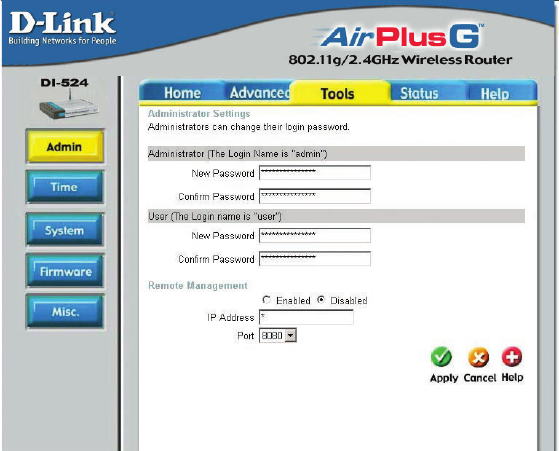
30
Using the Configuration Menu (continued)
Tools> Admin
At this page, the DI-524 administrator can change the system password. There are two
accounts that can access the Broadband Router’s Web-Management interface. They
are admin and user. Admin has read/write access while user has read-only access. User
can only view the settings but cannot make any changes.
Remote Management- Remote management allows the DI-524 to be configured from
the Internet by a web browser. A username and password is still required to access the
Web-Management interface. In general, only a member of your network can browse the
built-in web pages to perform Administrator tasks. This feature enables you to perform
Administrator tasks from the remote (Internet) host.
IP Address- The Internet IP address of the computer that has access to the Broadband
Router. If you input an asterisk (*) into this field, then any computer will be able to access
the Router. Putting an asterisk (*) into this field would present a security risk and is not
recommended.
Port- The port number used to access the Broadband Router.
Example- http://x.x.x.x:8080 where x.x.x.x is the WAN IP address of the Broadband
Router and 8080 is the port used for the Web-Mangement interface.
Administrator-
Password-
admin is the Administrator login name.
Enter the password and enter again to confirm.
User-
Password-
user is the User login name.
Enter the password and enter again to confirm.
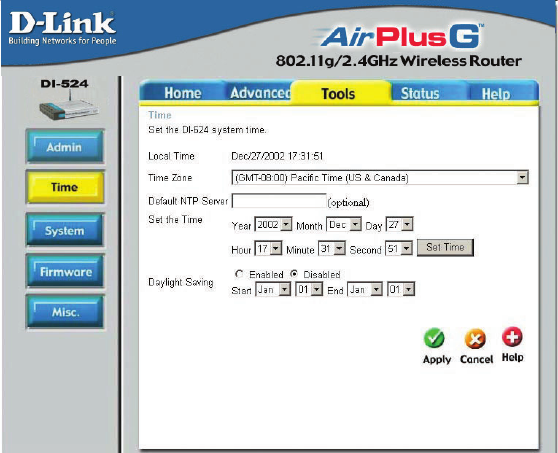
31
Using the Configuration Menu (continued)
Tools > Time
Time Zone- Select the Time Zone from the pull-down menu.
Daylight
Saving- To select Daylight Saving time manually, select enabled or dis-
abled, and enter a start date and an end date for daylight saving
time.
Set the Time- To manually input the time, enter the values in these fields for
the Year, Month, Day, Hour, Minute, and Second. Click Set Time.
Default
NTP Server- NTP is short for Network Time Protocol. NTP synchronizes com-
puter clock times in a network of computers.
This field is optional.
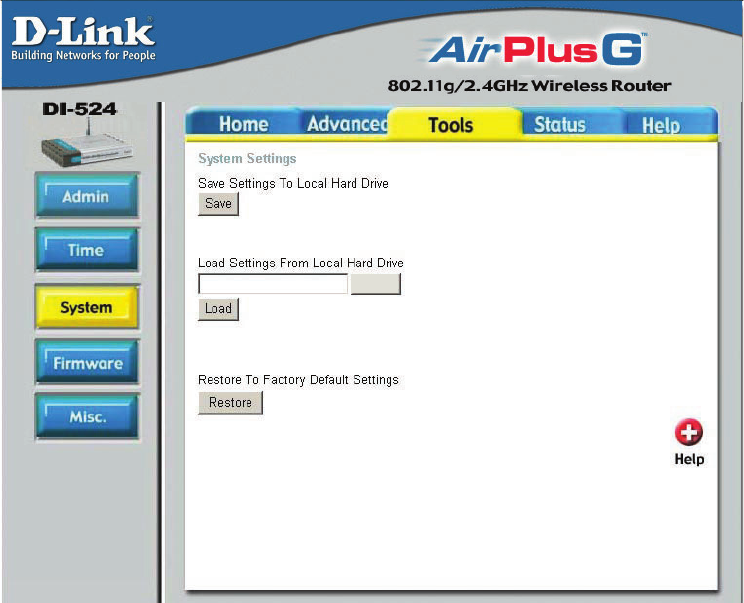
32
Using the Configuration Menu (continued)
Tools > System
The current system settings can be saved as a file onto the local hard drive. The saved
file or any other saved setting file can be loaded back on the Broadband Router. To reload
a system settings file, click on Browse to browse the local hard drive and locate the
system file to be used. You may also reset the Broadband Router back to factory set-
tings by clicking on Restore.
Click Save to save the current settings to the local Hard Drive.
Click Browse to find the settings, then click Load.
Save Settings to
Local Hard Drive-
Load Settings from
Local Hard Drive-
Restore to Factory
Default Settings- Click Restore to restore the factory default settings.
Browse
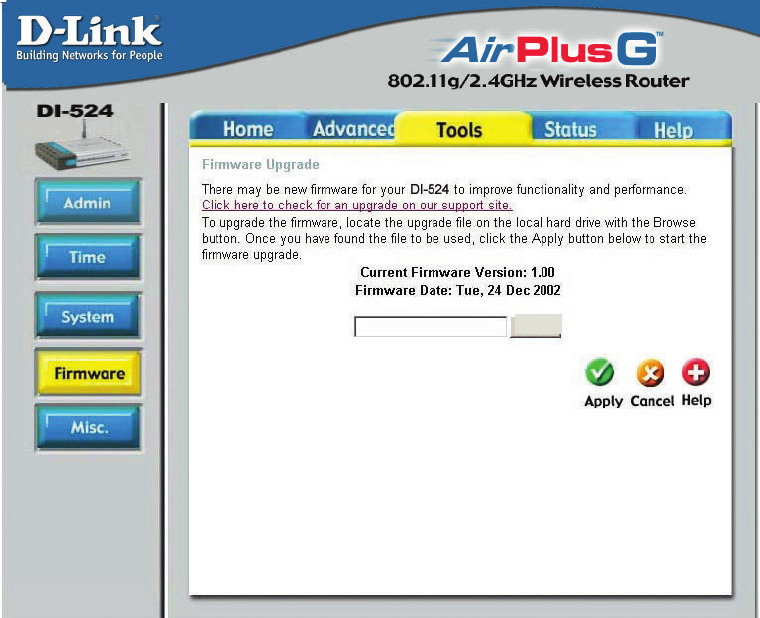
33
Using the Configuration Menu (continued)
Tools > Firmware
You can upgrade the firmware of the Router here. Make sure the firmware you want to
use is on the local hard drive of the computer. Click on Browse to browse the local hard
drive and locate the firmware to be used for the update. Please check the D-Link support
site for firmware updates at http://support.dlink.com. You can download firmware up-
grades to your hard drive from the D-Link support site.
Firmware Upgrade-
Browse-
Click on the link in this screen to find out if there is an updated
firmware; if so, download the new firmware to your hard drive.
After you have downloaded the new firmware, click Browse in
this window to locate the firmware update on your hard drive.
Click Apply to complete the firmware upgrade.
Browse
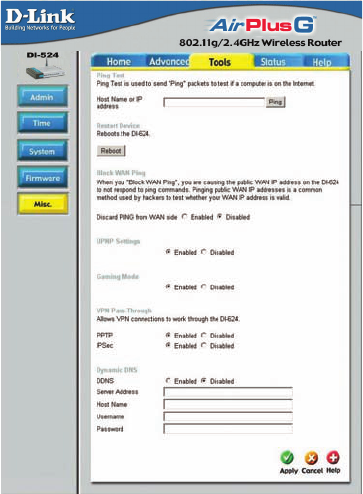
34
Using the Configuration Menu (continued)
Tools > Misc
Ping Test-
Restart
Device-
Block
WAN
Ping-
Discard Ping from
WAN side-
VPN
Pass
Through-
PPTP- select Enabled or Disabled
IPSec- select Enabled or Disabled
The Ping Test is used to
send Ping packets to test if
a computer is on the
Internet. Enter the IP Ad-
dress that you wish to Ping,
and click Ping.
If you choose to block WAN
Ping, the WAN IP Address
of the DI-524 will not respond
to pings. Blocking the Ping
may provide some extra se-
curity from hackers.
The DI-524 supports VPN (Virtual Private Network) pass-through
for both PPTP (Point-to-Point Tunneling Protocol) and IPSec
(IP Security). Once VPN pass-through is enabled, there is no
need to open up virtual services. Multiple VPN connections can
be made through the DI-524. This is useful when you have many
VPN clients on the LAN network.
Click Reboot to restart the
DI-524.
Click Enabled to block the
WAN ping.
UPNP-
Gaming
Mode-
Dynamic
DNS-
To use the Universal Plug and Play feature click on Enabled. UPNP
provides compatibility with networking equipment, software and periph-
erals of the over 400 vendors that cooperate in the Plug and Play forum.
Gaming mode allows a form of pass-through for certain Internet Games.
If you are using Xbox, Playstation2 or a PC, make sure you are using
the latest firmware and Gaming Mode is enabled. To utilize Gaming
Mode, click Enabled. If you are not using a Gaming application, it is
recommended that you Disable Gaming Mode.
Dynamic Domain Name System is a method of keeping a domain name
linked to a changing IP Address. This is a useful feature since many
computers do not use a static IP address.
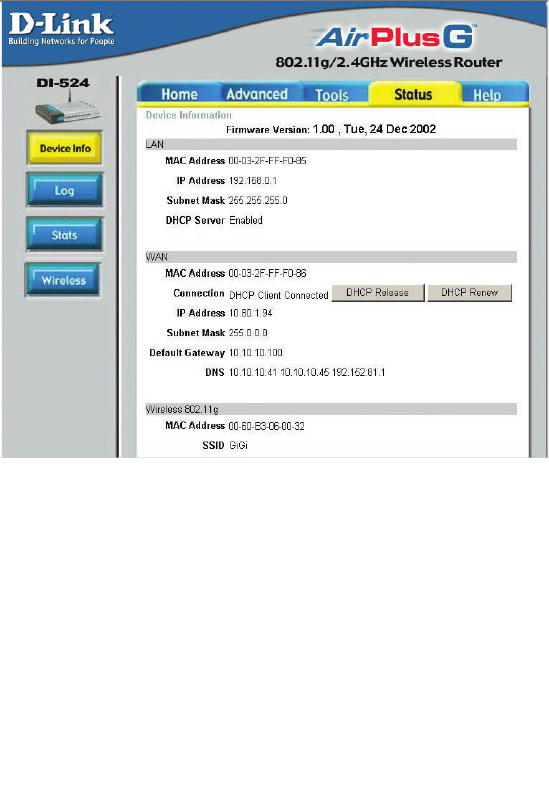
35
Using the Configuration Menu (continued)
Status > Device Info
This page displays the current information for the DI-524. It will display the LAN, WAN,
and MAC address information.
If your WAN connection is set up for a Dynamic IP address then a Release button and
a Renew button will be displayed. Use Release to disconnect from your ISP and use
Renew to connect to your ISP.
If your WAN connection is set up for PPPoE, a Connect button and a Disconnect button
will be displayed. Use Disconnect to drop the PPPoE connection and use Connect to
establish the PPPoE connection.
This window will show the DI-524’s working status:
IP Address: WAN/Public IP Address
Subnet Mask: WAN/Public Subnet Mask
Gateway: WAN/Public Gateway IP Address
Domain Name Server: WAN/Public DNS IP Address
WAN Status: WAN Connection Status
Wireless-
WAN-
MAC Address: Displays the MAC address
SSID: Displays the current SSID
Channel: Displays the current channel
WEP: Indicates whether WEP is enabled or disabled
IP Address: LAN/Private IP Address of the DI-524
Subnet Mask: LAN/Private Subnet Mask of the DI-524
LAN-
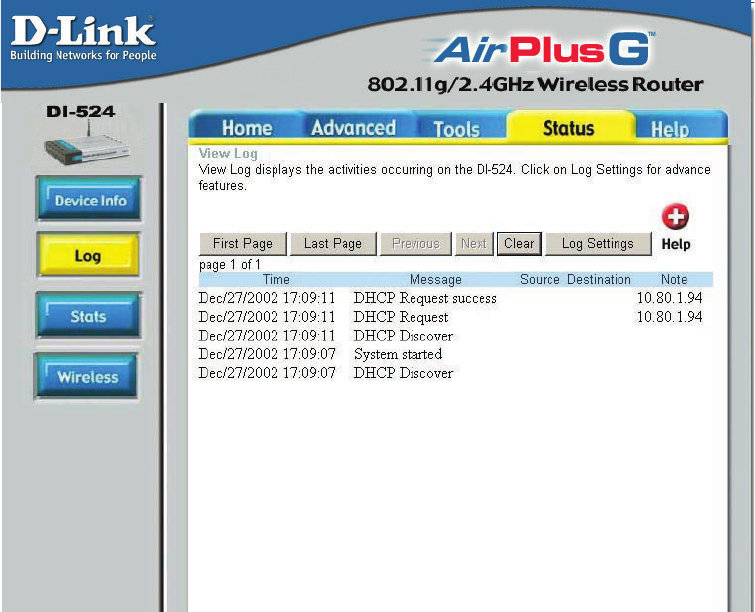
36
The Broadband Router keeps a running log of events and activities occurring on the
Router. If the device is rebooted, the logs are automatically cleared. You may save the log
files under Log Settings.
Using the Configuration Menu (continued)
Status > Log
View Log-
DI-754
First Page - The first page of the log.
Last Page - The last page of the log.
Previous - Moves back one log page.
Next - Moves forward one log page.
Clear - Clears the logs completely.
Log Settings - Brings up the page to configure the log.
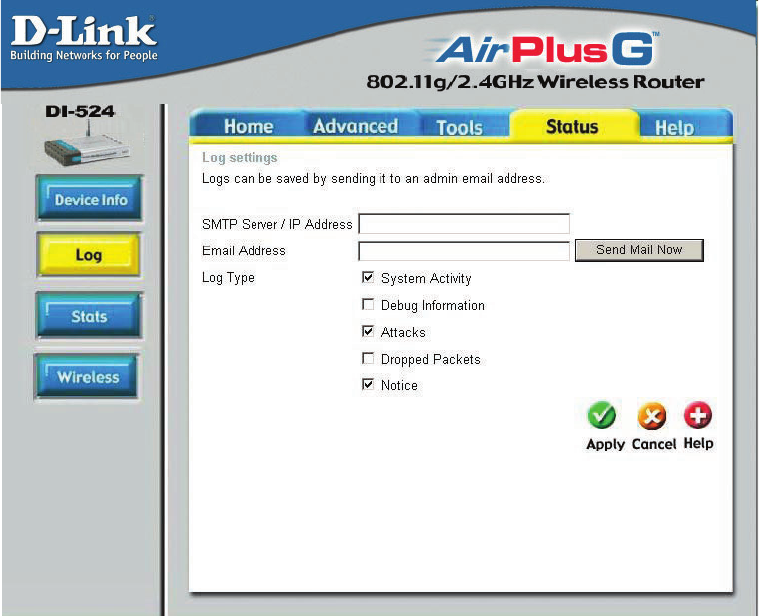
37
Using the Configuration Menu (continued)
Status > Log > Log Settings
Not only does the Broadband Router display the logs of activities and events, it can setup
to send these logs to another location.
The address of the SMTP server that will be used to send the logs.
The email address to which the logs will be sent.
Click on Send Mail Now to send the email.
SMTP Server/
IP Address -
Email Address -
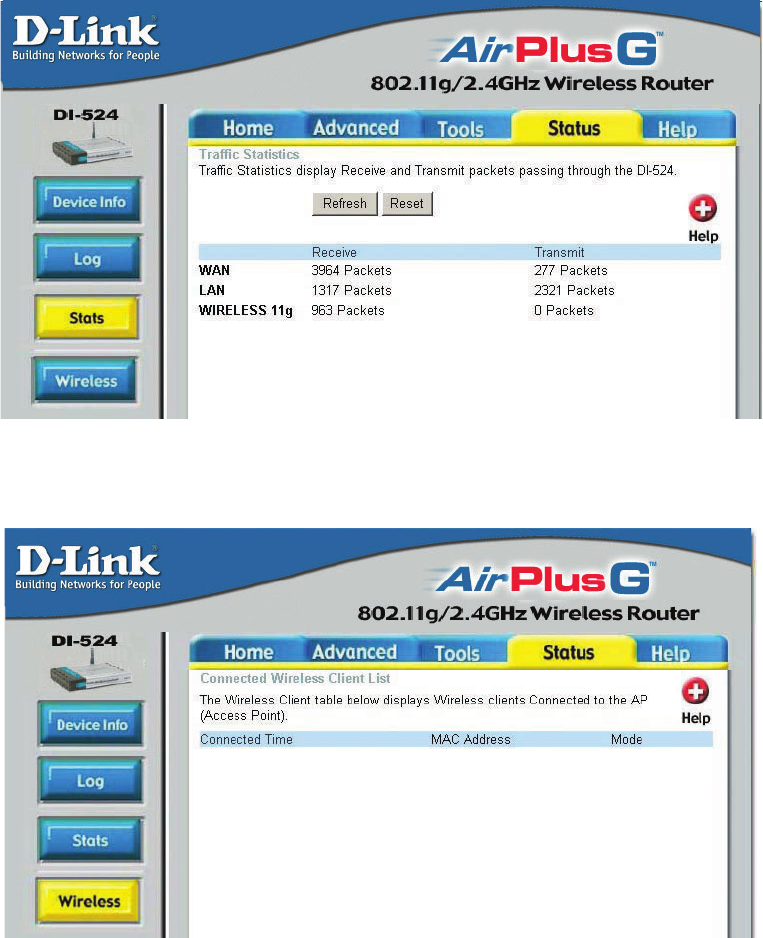
38
Status > Wireless
Using the Configuration Menu (continued)
Status > Stats
The screen above displays theTraffic Statistics. Here you can view the amount of pack-
ets that pass through the DI-524 on both the WAN and the LAN ports. The traffic counter
will reset if the device is rebooted.
The wireless client table displays a list of current connected wireless clients. This
table also displays the connection time and MAC address of the connected wireless
client.
Click on Help at any time, for more information.
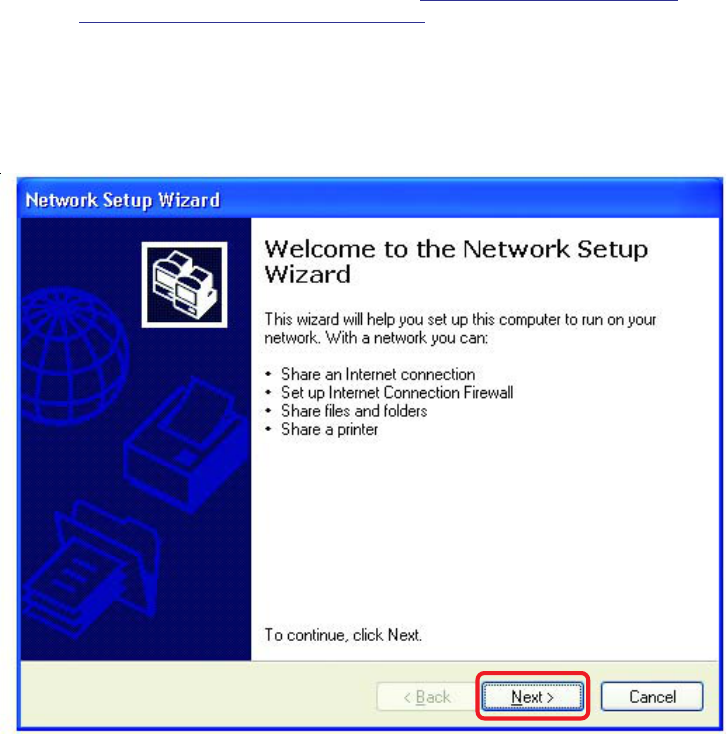
39
Using the Network Setup Wizard in Windows XP
In this section you will learn how to establish a network at home or work, using
Microsoft Windows XP.
Note: Please refer to websites such as http://www.homenethelp.com
and http://www.microsoft.com/windows2000 for information about networking
computers using Windows 2000, ME or 98.
Go to Start>Control Panel>Network Connections
Select Set up a home or small office network
Networking Basics
When this screen appears, Click Next.
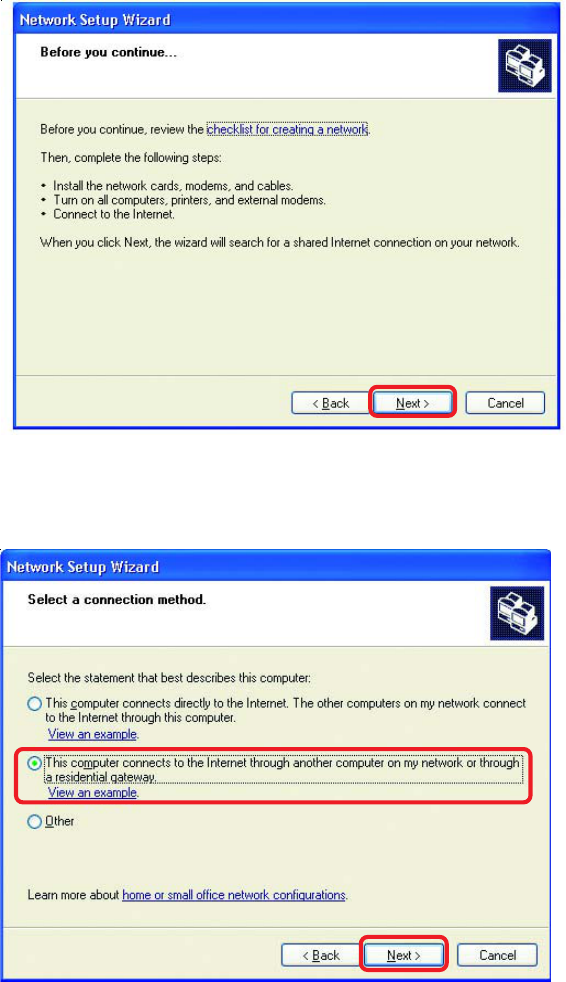
40
Please follow all the instructions in this window:
Networking Basics
Click Next
In the following window, select the best description of your computer. If your computer
connects to the internet through a gateway/router, select the second option as shown.
Click Next
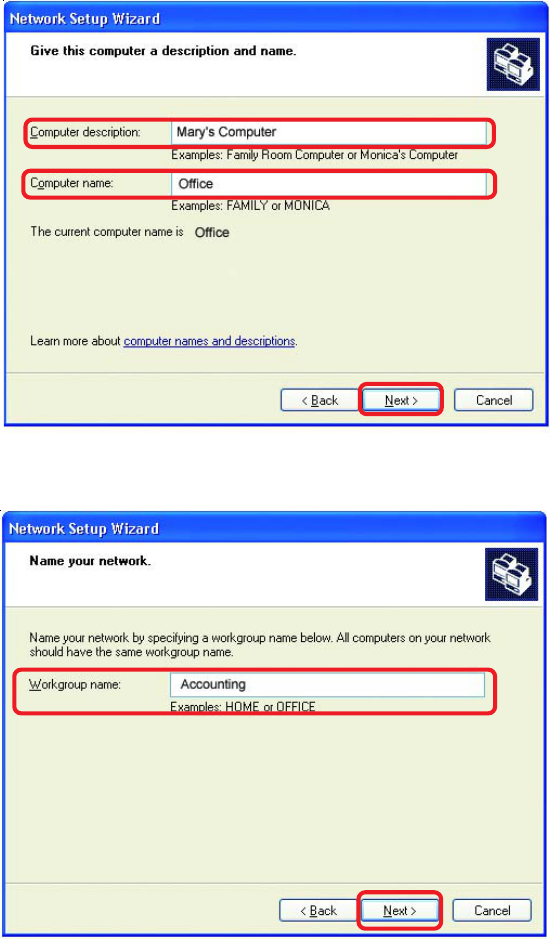
41
Enter a Computer description and a Computer name (optional.)
Networking Basics
Click Next
Enter a Workgroup name. All computers on your network should have the same
Workgroup name.
Click Next
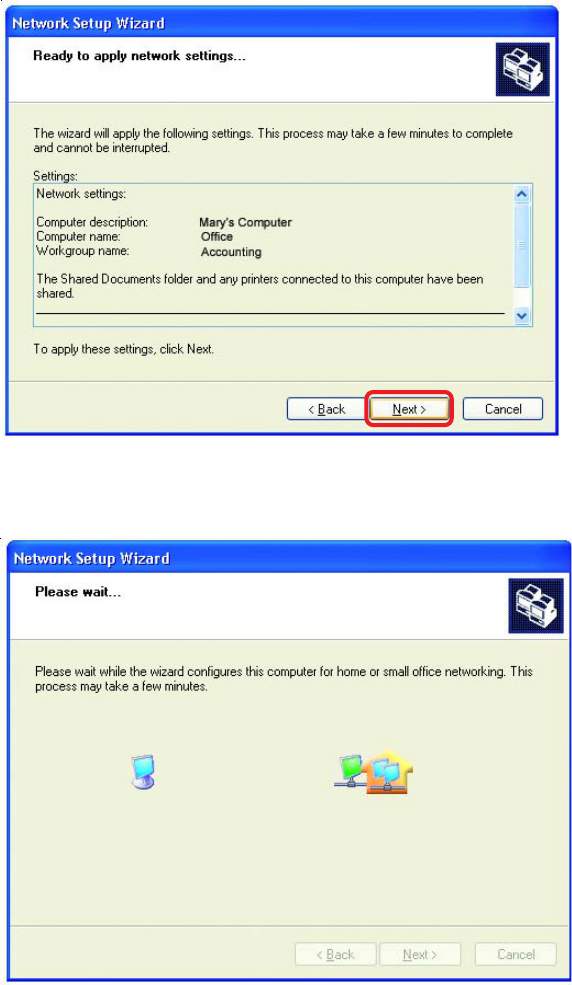
42
Please wait while the Network Setup Wizard applies the changes.
Networking Basics
When the changes are complete, click Next.
Please wait while the Network Setup Wizard configures the computer.
This may take a few minutes.
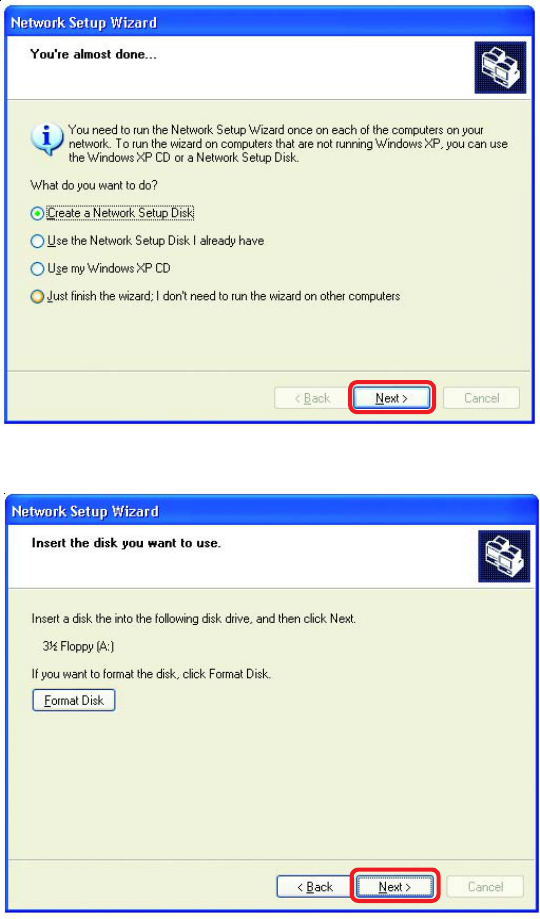
43
Networking Basics
In the window below, select the option that fits your needs. In this example, Create a
Network Setup Disk has been selected. You will run this disk on each of the
computers on your network. Click Next.
Insert a disk into the Floppy Disk Drive, in this case drive A.
Click Next.
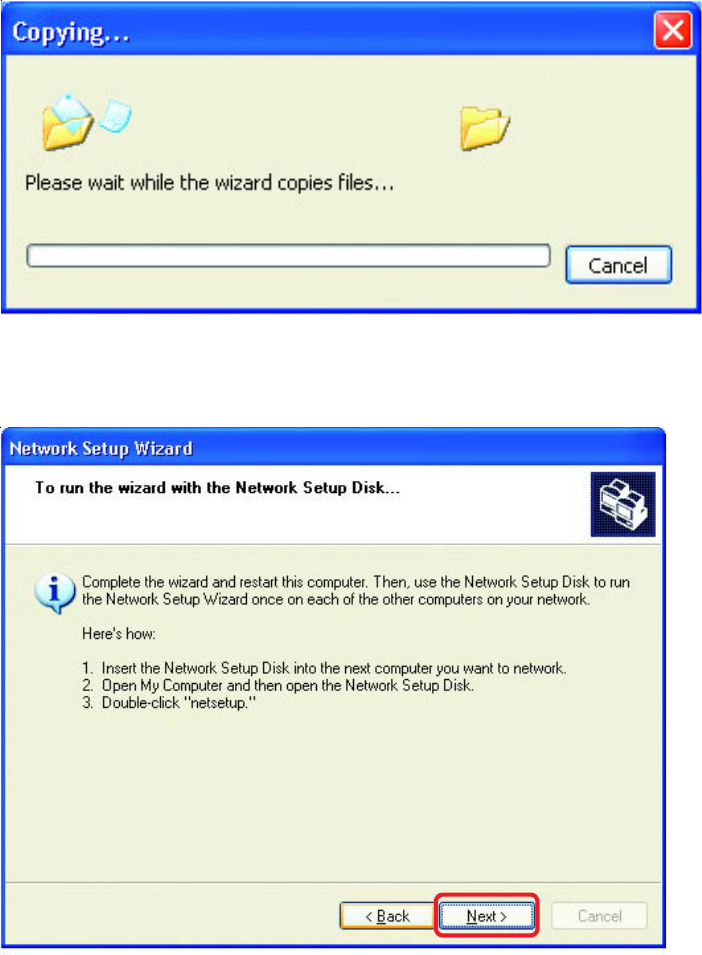
44
Networking Basics
Please read the information under Here’s how in the screen below. After you complete
the Network Setup Wizard you will use the Network Setup Disk to run the Network
Setup Wizard once on each of the computers on your network. To continue click Next.
Please wait while the Network Setup Wizard copies the files.
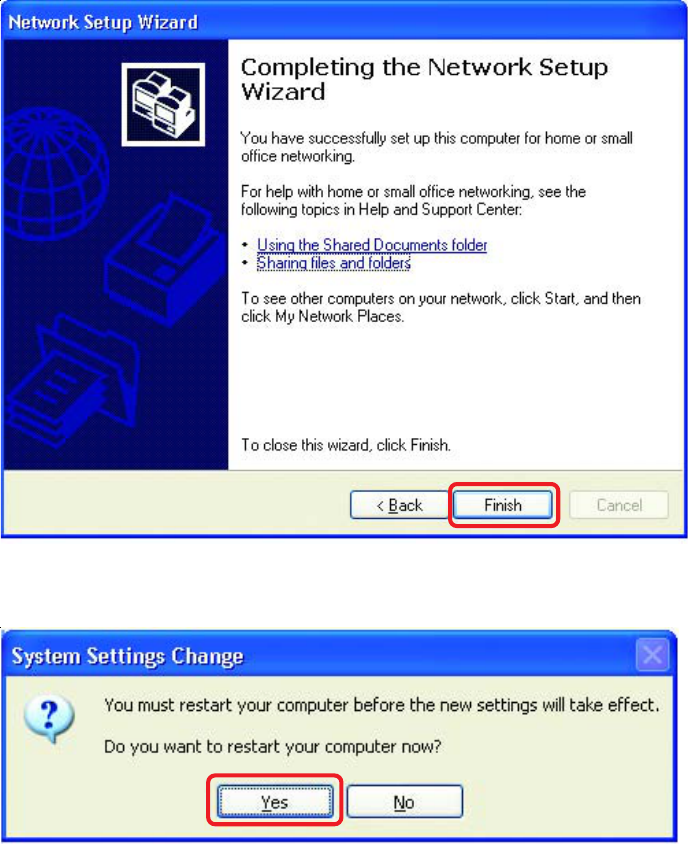
45
Networking Basics
Please read the information on this screen, then click Finish to complete the
Network Setup Wizard.
The new settings will take effect when you restart the computer. Click Yes to restart
the computer.
You have completed configuring this computer. Next, you will need to run the Network
Setup Disk on all the other computers on your network. After running the Network
Setup Disk on all your computers, your new wireless network will be ready to use.
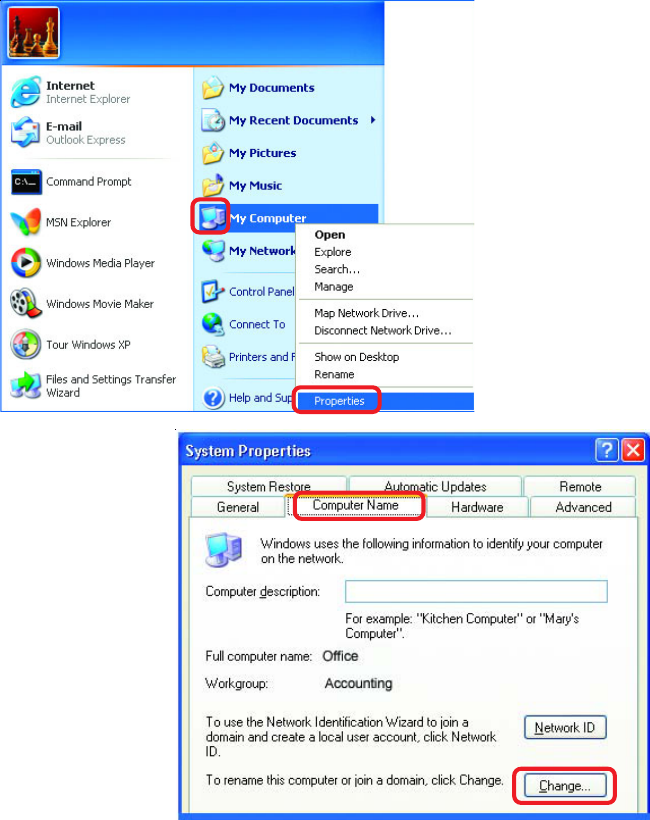
46
Networking Basics
Naming your Computer
To name your computer, please follow these directions:In Windows XP:
Click Start (in the lower left corner of the screen).
Right-click on My Computer.
Select Properties and click.
Select the Computer
Name Tab in the System
Properties window.
You may enter a
Computer Description if
you wish; this field is
optional.
To rename the computer
and join a domain, Click
Change.
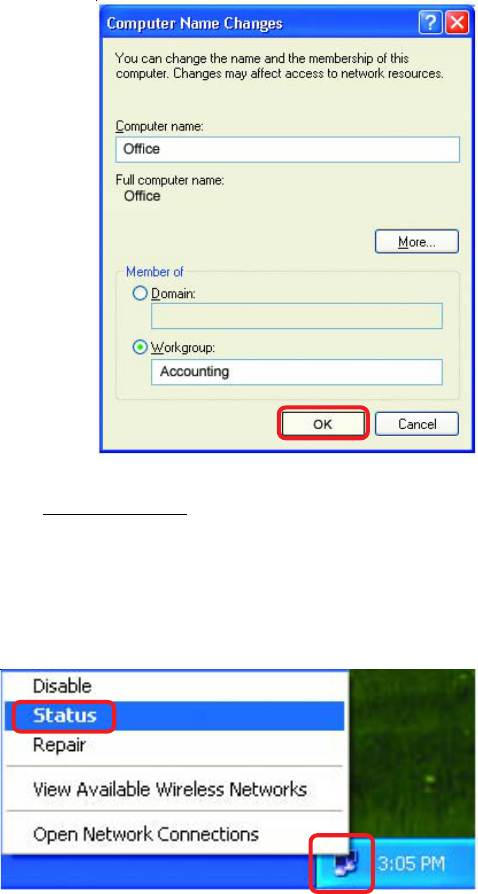
47
Networking Basics
Naming your Computer
In this window, enter the
Computer name.
Select Workgroup and enter
the name of the Workgroup.
All computers on your network
must have the same
Workgroup name.
Click OK.
Checking the IP Address in Windows XP
The wireless adapter-equipped computers in your network must be in the same IP Ad-
dress range (see Getting Started in this manual for a definition of IP Address Range.) To
check on the IP Address of the adapter, please do the following:
Right-click on the
Local Area
Connection icon
in the task bar.
Click on Status.
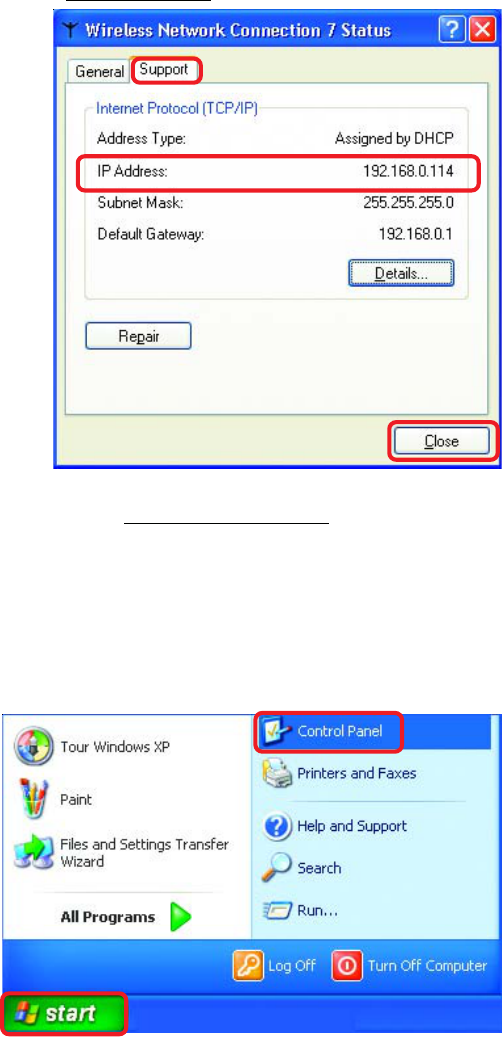
48
Networking Basics
Checking the IP Address in Windows XP
This window will appear.
Click the
Support tab
Click Close
Assigning a Static IP Address in Windows XP/2000
Note: Residential Gateways/Broadband Routers will automatically assign IP Addresses
to the computers on the network, using DHCP (Dynamic Host Configuration Protocol)
technology. If you are using a DHCP-capable Gateway/Router you will not need to assign
Static IP Addresses.
If you are not using a DHCP capable Gateway/Router, or you need to assign a Static IP
Address, please follow these instructions:
Go to Start
Double-click on
Control Panel
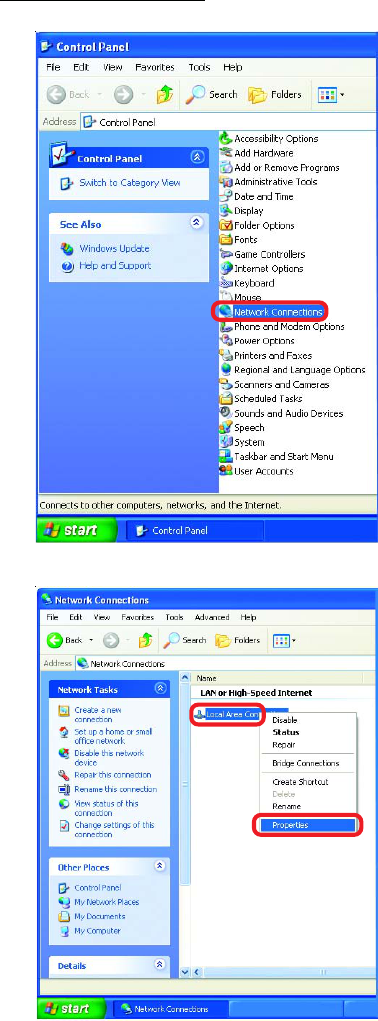
49
Networking Basics
Assigning a Static IP Address in Windows XP/2000
Double-click on
Network
Connections
Double-click on
Properties
Right-click on Local Area
Connections
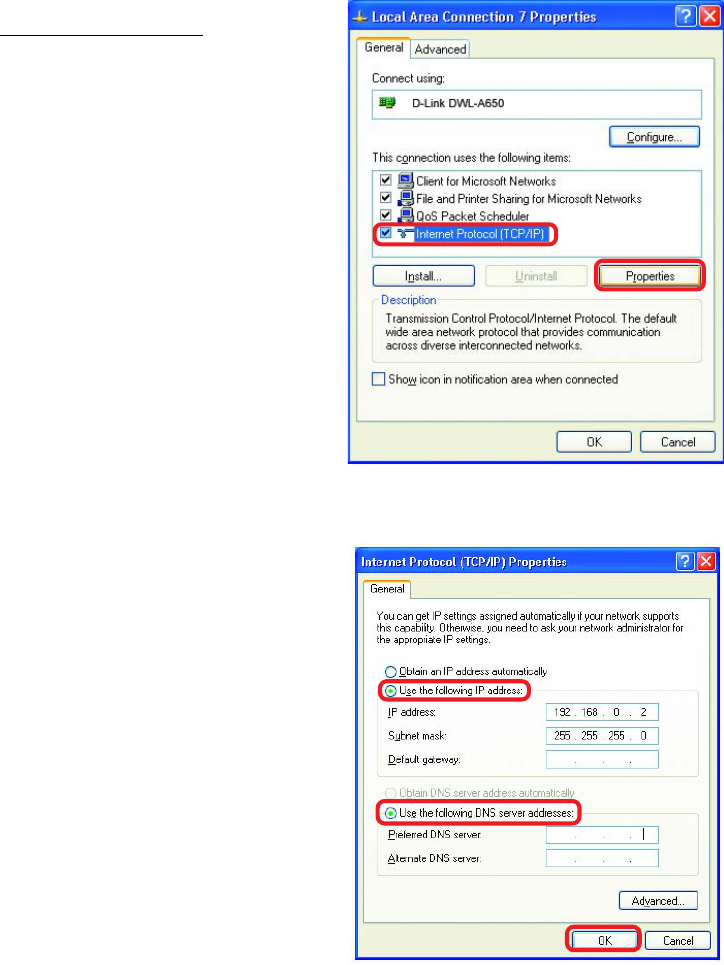
50
Input your IP address and
subnet mask. (The IP
Addresses on your network
must be within the same
range. For example, if one
computer has an IP Address
of 192.168.0.2, the other
computers should have IP
Addresses that are
sequential, like 192.168.0.3
and 192.168.0.4. The subnet
mask must be the same for
all the computers on the
network.)
Networking Basics
Assigning a Static IP Address
in Windows XP/2000
Input your DNS server
addresses. (Note: If you
are entering a DNS
server, you must enter the
IP Address of the Default
Gateway.)
The DNS server information will be supplied
by your ISP (Internet Service Provider.)
Click OK
Click on Internet Protocol
(TCP/IP)
Click Properties
Select Use the following IP
address in the Internet
Protocol (TCP/IP) Properties
window (shown below)